15 Most Sustainable Cotton Clothing Brands: The Conscious Consumer’s Guide
Affiliate Disclosure
Hey fellow impactful ninja ?
You may have noticed that Impactful Ninja is all about providing helpful information to make a positive impact on the world and society. And that we love to link back to where we found all the information for each of our posts.
Most of these links are informational-based for you to check out their primary sources with one click.
But some of these links are so-called "affiliate links" to products that we recommend.
Why do we add these product links?
First and foremost, because we believe that they add value to you. For example, when we wrote a post about the environmental impact of long showers, we came across an EPA recommendation to use WaterSense showerheads. So we linked to where you can find them. Or, for many of our posts, we also link to our favorite books on that topic so that you can get a much more holistic overview than one single blog post could provide.
And when there is an affiliate program for these products, we sign up for it. For example, as Amazon Associates, we earn from qualifying purchases.
What do these affiliate links mean for you?
First, and most importantly, we still only recommend products that we believe add value for you.
When you buy something through one of our affiliate links, we may earn a small commission - but at no additional costs to you.
And when you buy something through a link that is not an affiliate link, we won’t receive any commission but we’ll still be happy to have helped you.
What do these affiliate links mean for us?
When we find products that we believe add value to you and the seller has an affiliate program, we sign up for it.
When you buy something through one of our affiliate links, we may earn a small commission (at no extra costs to you).
And at this point in time, all money is reinvested in sharing the most helpful content with you. This includes all operating costs for running this site and the content creation itself.
What does this mean for me personally?
You may have noticed by the way Impactful Ninja is operated that money is not the driving factor behind it. It is a passion project of mine and I love to share helpful information with you to make a positive impact on the world and society. However, it's a project in that I invest a lot of time and also quite some money.
Eventually, my dream is to one day turn this passion project into my full-time job and provide even more helpful information. But that's still a long time to go.
Stay impactful,
Cotton is the most commonly used natural fiber, yet it is notorious for its production pollution, exploitation, and even modern-day slavery. Recycled cotton and organic cotton are preferred because they bypass the most adverse environmental impacts of conventional cotton cultivation. Unfortunately, fashion greenwashing makes it harder for you and all other consumers to determine which brands offer the most eco-friendly cotton garments. So, we had to ask: Which are the most sustainable cotton clothing brands?
The most sustainable cotton clothing brands are Patagonia, Reformation, and Tentree, which cut down the carbon footprint, employ full traceability, and strive for circularity. In addition, Eileen Fisher and Outerknown use low-impact, high-quality, recycled materials and adhere to ethical practices.
Whether you are searching for a versatile top, an elegant dress, or some comfortable underwear to add to your wardrobe without negatively impacting the soil, the water, the animals, and other people, there is a brand for you. So, let’s keep reading to learn more about the most sustainable cotton clothing brands and how they ensure sustainable, ethical practices.
Here’s How Sustainable Cotton Fabrics Generally Are
Cotton fabrics are made with natural fibers, but the conventional cultivation of cotton fibers and production of cotton fabrics are rampant with harmful chemicals while being water and energy-intensive. However, such adverse environmental impacts can be reduced by sourcing responsible, regenerative, and organic cotton. It’s also important to note that recycled cotton is ranked class A—the most sustainable category of fibers by The Common Objective’s Made-By Environmental Benchmark for Fibres.
“Sustainable: The ability to be maintained at a certain rate or level | Avoidance of the depletion of natural resources in order to maintain an ecological balance”
Oxford Dictionary
To understand the sustainability of cotton, we’ve assessed the life-cycle and each stage’s sustainability. This life-cycle assessment (LCA) is a method to evaluate the environmental impacts of products and materials. Here’s the quick summary of our LCA of cotton!
What makes sustainable cotton: Recycled cotton is considered the most sustainable variety of cotton because using discarded materials to make recycled cotton fabrics reduces pressure on land, water, and other resources needed for cotton cultivation. At the same time, diverting discarded fabrics back into the economy slows down the demand for land needed for waste storage.
Additionally: Cotton fabrics made with fibers from organic and regenerative farming systems are also considered sustainable because these natural fibers are cultivated ethically without any added toxic synthetic chemicals and, thus, are fully biodegradable at the end of their life.
Here’s How We Selected the Most Sustainable Cotton Clothing Brands
The brands on this list were chosen based on their commitment and actions to promote sustainable practices while reducing the environmental impacts of the textile industry.
They are transparent about their materials, processes, and workforce management within their supply chain.
Some brands focus their efforts on reducing waste and optimizing natural resources while others strive to reduce the carbon footprint of their clothes.
All of these brands share the commitment to reshape the textile industry toward a more sustainable and Earth-friendly sector.
These Are the 15 Most Sustainable Cotton Clothing Brands
Most Sustainable Cotton Clothing Brands
Overall, these cotton clothing brands are sustainable. Yet, they take various approaches to reduce environmental impacts and uphold ethical standards. Let’s dive into each brand and find out more.
Patagonia: Everyday Wear for Those Who Care
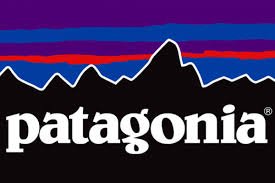

“Together, we can prioritize purpose over profit and protect this wondrous planet, our only home.”
Patagonia
🌎
How do they ensure their sustainability?
Patagonia puts sustainability at the center of their operation. They work to reduce, rather than simply offset, carbon emissions where it matters the most: in the supply chain and material manufacturing. They reduce their carbon footprint by removing high-impact virgin fossil-based fibers from their collections, using “Environmental Profit and Loss” to guide their production decision, and helping their suppliers to cut emissions. Patagonia’s fall 2023 collection is made up mostly of preferred materials (91% by fabric weight), including recycled cotton, regenerative organic cotton, hemp, man-made cellulose fibers, and. On top of that, Patagonia’s Worn Wear program encourages customers to repair and recycle their products, extending the textile lifecycle and reducing waste. Lastly, Patagonia is certified as a B Corporation and a Bluesign® brand.
🌐
How do they ensure their ethics?
Patagonia commits to fair trade practices. Through the partnership with Fair Trade USA, they currently produce 86% of their clothes in 20 Fair Trade Certified factories. Patagonia pays a premium for every item produced in such factories, accumulating in a fund for workers to use in their chosen community projects, whether in healthcare or parent support or to withdraw as a cash bonus. Additionally, they have various social responsibility programs to prevent harm and create positive impacts on the lives of apparel workers in their supply chain. These include the Fair Labor Association, the Living Wage Program, the Migrant Workers Program, and the Responsible Purchasing Practices. Patagonia is also fully transparent about the locations of their facilities and suppliers. Regarding animal rights, Patagonia has developed the Patagonia Wool Standard, which uses the Responsible Wool Standard as a foundation but goes beyond it in several key areas of animal welfare practices.
🤝
Are they part of any giving-back programs?
Since 1985, Patagonia has pledged 1% of sales annually to environmental causes. They have awarded over $89 million in cash and in-kind donations to domestic and international grassroots environmental groups, making a difference in their local communities. In 2022, the founder of Patagonia gave away his family’s ownership of the company to the newly created Patagonia Purpose Trust and the not-for-profit organization Holdfast Collective, ensuring that all future profits from the company are used to fight the climate and extinction crisis.
🛍️
What is their product range?
- Best for: kidswear, menswear, womenswear
- Product range: shirts, pants, jackets, blazers, hoodies, sweatshirts, T-shirts, shorts, plus-size
- Price range: $$$
- Size range: XXS–XXXL
Reformation: Clothes Made Smarter, Better, and for Good

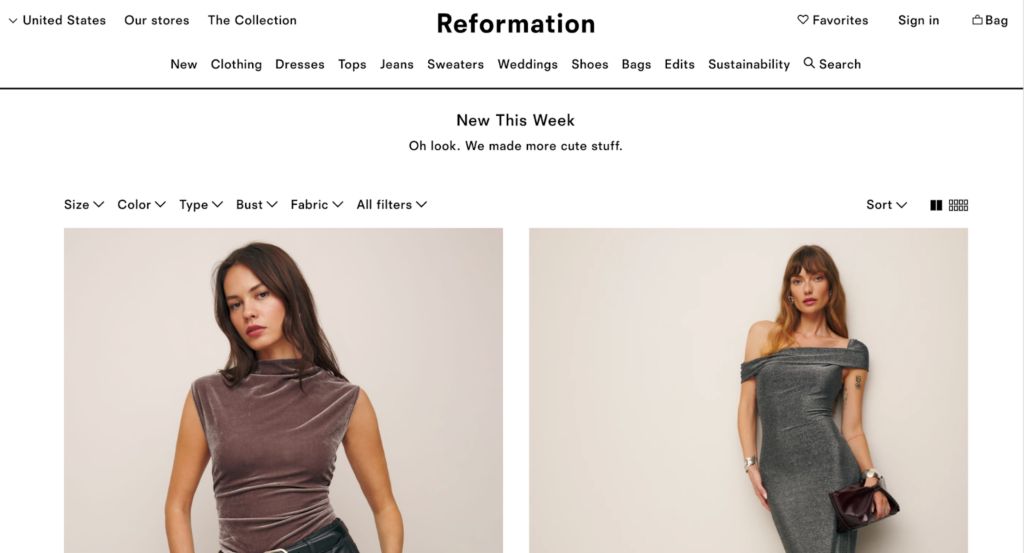
“We’re committed to pushing the industry forward and investing in future-focused solutions, which is why we’re a certified Climate Neutral company and will be Climate Positive by 2025.”
Reformation
🌎
How do they ensure their sustainability?
Reformation commits to better fabrics, aiming to trade all virgin materials for recycled, regenerative, or renewable ones by 2025. Their most-preferred fabrics include recycled cotton, regenerative cotton, TENCEL™ lyocell, TENCEL™x Refibra, and deadstock, accounting for 32% of all their clothes. They commit to becoming circular by 2030 by designing out waste at every stage of production, turning any occurring production waste into new products, and using renewable and regenerative practices for necessary virgin materials. Furthermore, their RefRecycling incentive enables customers to sell their preloved Reformation clothes for store credits. Such items will be broken down into fibers and turned into new products. Reformation also connects their suppliers with environmental solutions such as renewable energy, water-saving technologies, energy reduction solutions, chemical input optimization, and wastewater management. Last but not least, they openly share the carbon and water footprint of each product they make, fostering transparency and accountability in the fashion industry. Reformation is Bluesign® and Climate Neutral certified.
🌐
How do they ensure their ethics?
Reformation is fully transparent about where their clothes are made and the practices in such factories. Their Supplier Code of Conduct is based on International Labor Organization (ILO) standards. Their factory list shares many details about their factories, including whether a union and a collective bargaining agreement are present and the last audit. They have aligned with the Transparency Pledge and are participating in the Open Supply Hub to expand on the details that are made public so they can be more accountable for the working conditions in their partner factories. They give workers at their vendors a voice to bring up problems regarding their working conditions, level of happiness, working hours, and wages, and collaborate with vendors to ensure necessary improvements. Reformation is also a member of the Fair Labor Association, an initiative committed to promoting fair labor standards worldwide.
🤝
Are they part of any giving-back programs?
Reformation is not known to be part of any giving-back programs.
🛍️
What is their product range?
- Best for: womenswear
- Product range: dresses, tops, bodysuits, denim, cardigans, sweaters, wedding dresses, shoes
- Price range: $$$
- Size range: XS–XL
Tentree: A Lifestyle Clothing Brand That Plants Trees for Every Item Purchased

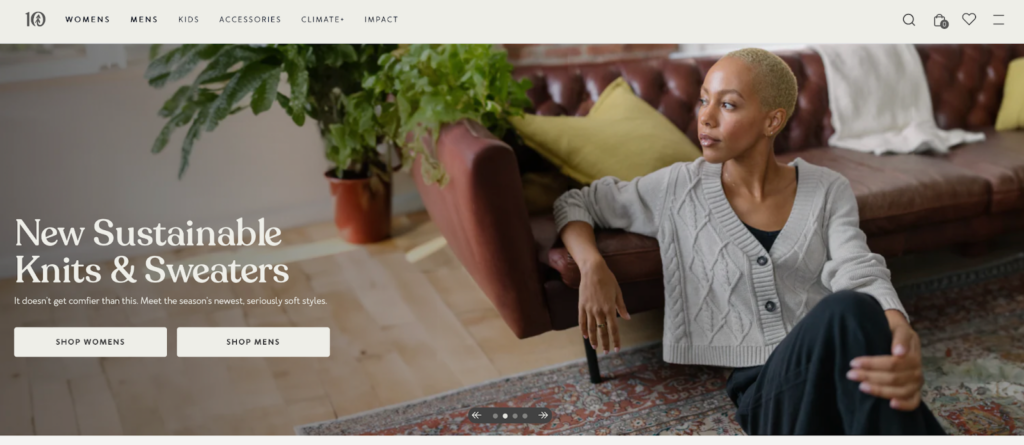
“ We believe the future of business is restorative.”
Tentree
🌎
How do they ensure their sustainability?
Tentree ensures sustainability by planting trees, promoting circularity, opting for low-impact fabrics, and attaining responsible packaging. Since their inception, they have planted more than 100,000,000 trees, which helps regenerate ecosystems, capture carbon, and provide forestry jobs in communities around the world. Together with textile recycler SuperCircle and resale guru Treet, Tentree has created an integrated solution to resell or recycle pre-loved Tentree clothing items, keeping them in circulation and out of landfills. Tentree also uses eco-friendly fabrics and blends, including organic cotton, hemp, recycled polyester, and TENCEL™. Regarding packaging, they replaced all single-use plastics with FSC-certified and 100% recycled paper. Finally, they have B Corporation and Climate Neutral certifications.
🌐
How do they ensure their ethics?
Tentree enforces fair labor practices by collaborating only with manufacturers and suppliers that guarantee a safe and respectful environment for their employees. They regularly audit their partner facilities to ensure compliance with their Code of Conduct and international labor standards. Part of their supply chains is certified by organizations that protect workers, such as Fair Wear Foundation, Global Organic Textile Standard, Sedex Members Ethical Trade Audit, and Worldwide Responsible Accredited Production – WRAP. Additionally, Tentree commits to protecting forests through their paper, packaging, and fabric choices.
🤝
Are they part of any giving-back programs?
Giving back is a cornerstone of Tentree’s mission. Tentree plants 10 trees worldwide for every item purchased, contributing to reforestation and combating climate change. In 2022 alone, their customers helped plant over 22 million trees across nine countries, restoring over 2,000 hectares of terrestrial forests, over 1,000 hectares of coastal mangrove forests, and hundreds of hectares of marine land.
🛍️
What is their product range?
- Best for: kidswear, menswear, womenswear
- Product range: T-shirts, tank tops, shirts, sweaters, cardigans, dresses, pants, hoodies, dresses, shorts, skirts, joggers, jackets, coats, underwear
- Price range: $$
- Size range: XXS–XXL
Eileen Fisher: A Sustainable Fashion Brand Focusing on Eco-Friendly Materials and Textile Circularity
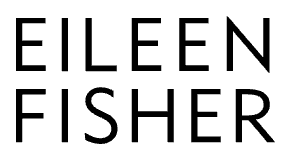
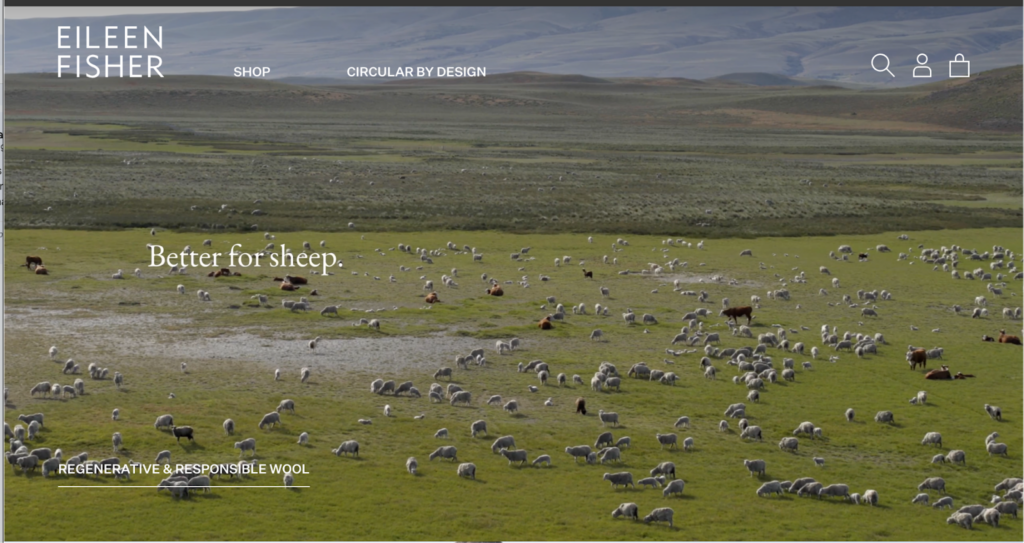
“The Biggest Thing We Can Do Is Reduce”
Eileen Fisher, founder of Eileen Fisher
🌎
How do they ensure their sustainability?
Eileen Fisher’s sustainability efforts focus on using eco-friendly materials, including recycled cotton, organic cotton, linen, and hemp, reducing greenhouse gas emissions generated from their operations and supply chain, reducing fabric and corporate waste, and recycling the brand’s used clothes back into new products. Their commitments to sustainable materials, circular systems, and environmentally friendly practices are demonstrated in initiatives like VISION 2020, Horizon 2030, and Renew. They are also certified as a B Corporation and a Bluesign® brand.
🌐
How do they ensure their ethics?
Eileen Fisher is committed to ethical practices. They have worker empowerment initiatives such as collective bargaining and the right to make a complaint. For example, their “Our Love, Peru” project supports over 450 families in and around Arequipa with higher fair trade wages and investments in the local community. Additionally, Their VISION 2020, set in 2015, tackled unethical labor practices.
🤝
Are they part of any giving-back programs?
Eileen Fisher supports many women-owned businesses. The brand has provided, since their inception, many grants for women, including the current program Supporting Women in Environmental Justice.
🛍️
What is their product range?
- Best for: elegant, classic, and casual women’s clothes
- Product range: dresses, blouses, sweaters, cardigans, pants, skirts and outerwear, shoes, accessories
- Price range: $$$
- Size range: XXS–3XL
Outerknown: Stylish Clothes Made Sustainably and Ethically

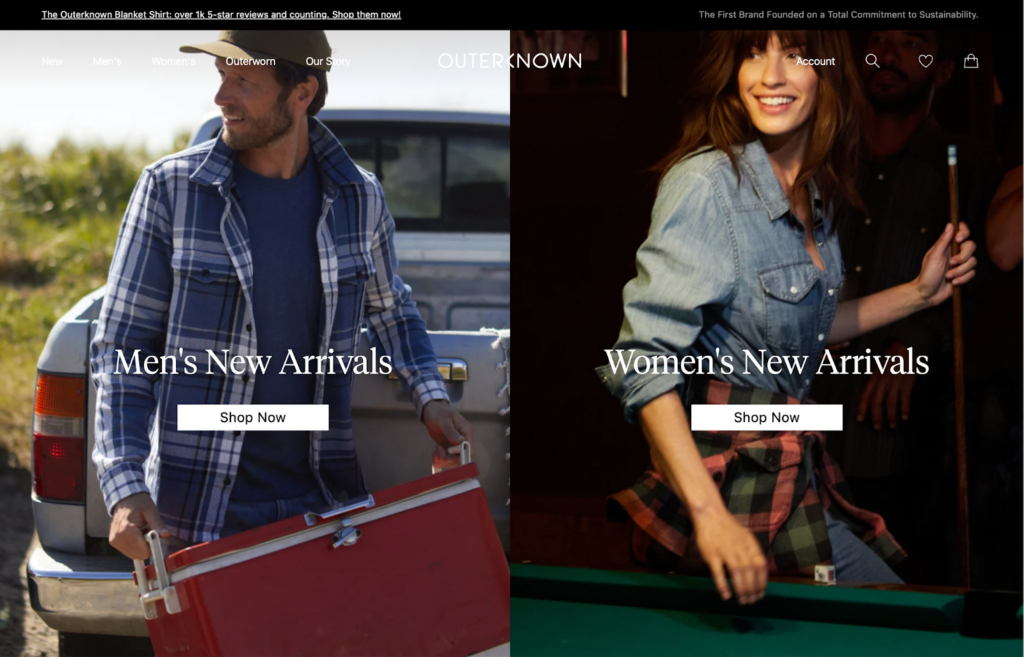
“We are driven by a passion for responsible action, courageous change, and great clothes.”
Outerknown
🌎
How do they ensure their sustainability?
Outerknown places sustainability at its core by using eco-friendly materials such as hemp, organic cotton, recycled cotton, and responsible wool in their clothing, reducing the environmental impact. In 2022, these preferred fibers accounted for 95% of their collection. The brand’s Outerworn platform offers customers a chance to buy and sell pre-loved pieces, contributing to closing the loop in fashion. They also partner with Project Vermont to give new purpose to materials that would otherwise end up in landfills. Additionally, Outerknown strives to reduce their footprint by working with two B Corp Certified suppliers and having eight facilities running on renewable energy.
🌐
How do they ensure their ethics?
Outerknown maintains ethics by promoting the highest labor standards in alignment with the Fair Labor Association. They publicly share their Code of Conduct, which covers all of the ILO Four Fundamental Freedoms principles. Outerknown provides Fairtrade Premium, which has improved workers’ livelihoods in their supply chain via workers’ chosen programs in healthcare, education, accommodation, and financial independence.
🤝
Are they part of any giving-back programs?
Outerknown gives back to non-profits that align with their values and help make a larger impact. They work with organizations like Brother Benno, The Ocean Cleanup, Ocean Conservancy, Surfrider Maui Chapter, Surfrider Foundation, and Everytown.
🛍️
What is their product range?
- Best for: menswear, womenswear
- Product range: shirts, pants, T-shirts, tops, sweaters, dresses, hoodies, shorts, denim, jackets, blazers, jumpsuits, playsuits, swimwear
- Price range: $$$
- Size range: XS–XL
Ecoalf: Committing to Recycling Waste and Cleaning the Environment

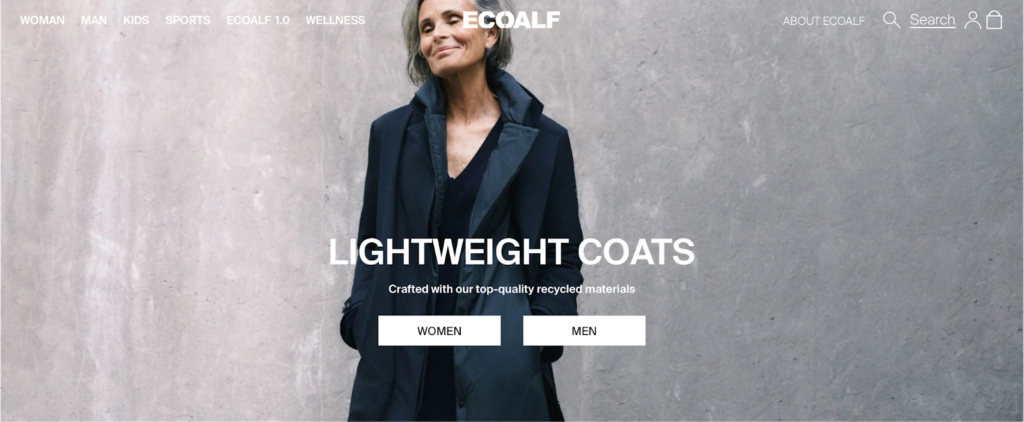
“I believe the time when fashion was just about looking good is over. More than ever it has to be about doing what is right and feeling good about it.”
Javier Goyeneche, founder of Ecoalf
🌎
How do they ensure their sustainability?
Ecoalf’s commitment to sustainability is evident in its innovative recycling practices. They minimize the use of natural resources by using mainly waste as raw materials, collecting and transforming discarded materials such as plastic bottles, discarded fishing nets, and post-industrial cotton into high-quality fashion items. In 2023, they launched their first 100% recycled cotton collection that can be recycled again to achieve circularity. In 2021, 74% of the materials used by Ecoalf were recovered from waste, saving 1,377 tons of CO₂. In combination with recycled fabrics, including mechanically recycled cotton, recycled wool, recycled polyester, and recycled nylon, Ecoalf uses a small percentage of low-impact natural fabrics, such as linen and kapok. Ecoalf is also Bluesign® and B Corporation certified.
🌐
How do they ensure their ethics?
Ecoalf ensures their ethics by protecting their workers and the environment. In particular, they ensure there are safe and fair working conditions in their supply chain by mandating a Code of Conduct, an Equality Scheme, a Crime Prevention Handbook, a Disciplinary System, and a Bullying at Work Protocol. Additionally, they run many campaigns to raise awareness of the state of our ocean and earth-damaging consumerism habits.
🤝
Are they part of any giving-back programs?
Ecoalf actively participates in giving-back programs. The Ecoalf Foundation was founded to clean the oceans of marine waste with the help of the fishing industry while giving a second life to plastic waste through recycling and closing the loop. They achieve that with the “Upcycling the Oceans” projects. In 2021, Ecoalf donated 10% of all Because There’s No Planet B sales to the Ecoalf Foundation to expand the “Upcycling the Oceans” project beyond the Spanish border and into countries like Thailand, Greece, and France. The foundation also partners with Biotherm to set up the framework of “Limpia ríos, salva océanos”, a project supported by corporate volunteer days to collect waste and restore the environment. Additionally, Ecoalf’s employees volunteer in various environmental incentives.
🛍️
What is their product range?
- Best for: womenswear, menswear, kidswear
- Product range: shirts, pants, jackets, blazers, hoodies, sweatshirts, tops, blouses, knitwear, T-shirts, sneakers, accessories
- Price range: $$
- Size range: XS–XL
Neu Nomads: An Ethic-First Brand With a Commitment to Sustainability and Traceability
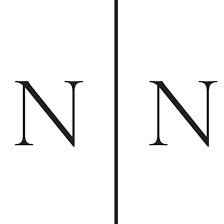
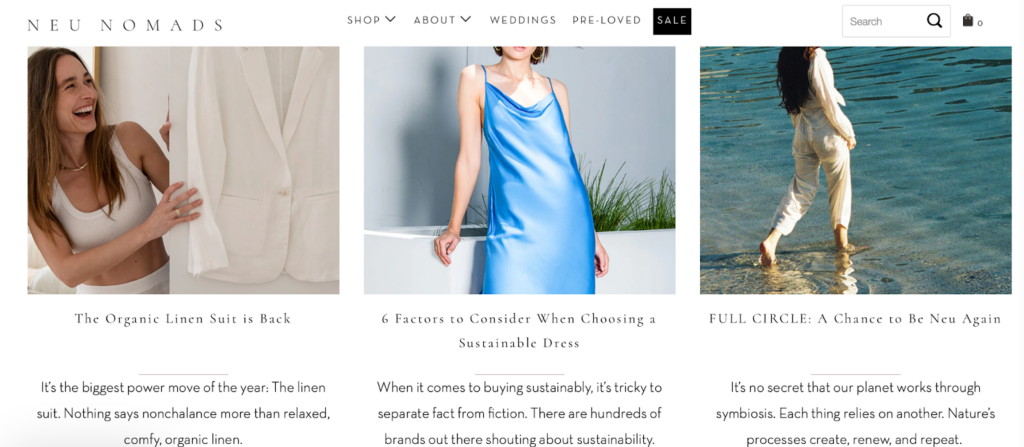
“We always consider how to create something beautiful with the lowest possible impact on the world.”
Karen Wood, founder of Neu Nomads
🌎
How do they ensure their sustainability?
Neu Nomads prioritizes sustainability by opting for eco-friendly materials, using renewable energy in their supply chain, and reducing waste with a platform to resell and reuse pre-loved clothes. Their biodegradable, plant-based fabrics include certified organic cotton, linen, and TENCEL™. Their factory in India is powered by solar energy, with all the excess energy directed back to the local community. Water used for dying fabrics is captured, purified, and processed using non-toxic and AZO-free dyes. Nearly 90% of the water used during dyeing is recycled in a common effluent treatment plant.
🌐
How do they ensure their ethics?
Neu Nomads ensures their ethics through fair labor practices and transparent supply chains. They make regular inspection visits to their suppliers. 85% of their garments are produced in a family-owned factory in Delhi that maintains healthy working conditions, health care benefits, and compensation far above the living wage.
🤝
Are they part of any giving-back programs?
Neu Nomads is not known to be part of any giving-back programs.
🛍️
What is their product range?
- Best for: luxurious essential clothing items for female modern travelers
- Product range: shirts, scarves, dresses, pants, jackets, blazers, knitwear, tops, blouses, T-shirts, lingerie
- Price range: $$$
- Size range: XXS–XXL
Whimsy + Row: Reducing Eco-Footprint With Every Step of the Process
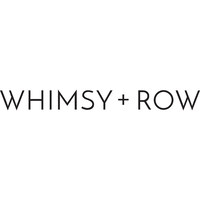
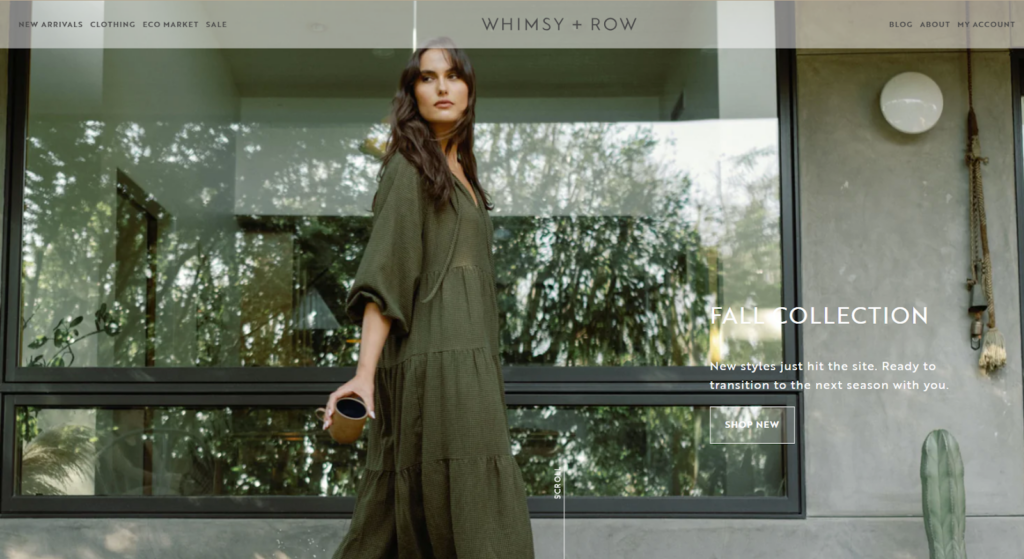
“Growing and being a good company.”
Rachel Temko, founder of Whimsy + Row
🌎
How do they ensure their sustainability?
Whimsy + Row prioritizes sustainability by opting for low-impact materials like certified organic cotton, linen, TENCEL™ lyocell, and deadstock/upcycled fabrics. Their clothes are made with low-impact dyes and recycled water. Furthermore, they reduce waste through their small-batch production of long-lasting products and efforts to close the loop to reach zero waste. The final stages of manufacturing are done locally to reduce the transportation footprint. They further offset their carbon emission with the Carbon Fund. Whimsy + Row is carbon neutral.
🌐
How do they ensure their ethics?
Whimsy + Row clothing is made within a few miles of their office, enabling weekly factory visits. The brand ensures that fair wages are given and that workers are being treated fairly.
🤝
Are they part of any giving-back programs?
Whimsy + Row actively participates in giving-back programs that support environmental causes and community initiatives. Specifically, they donate money to organizations like One Tree Planted, People Tree, Global Fund for Women, Black Lives Matter, Reclaim the Block, Black Vision Collective, Downtown Women’s Health Center, and Feeding America. Once a month, their employees also donate their time to community work, such as cleaning the beach or planting trees.
🛍️
What is their product range?
- Best for: womenswear with eco-friendly, contemporary designs
- Product range: skirts, denim, dresses, pants, tops, blouses, shorts, lingerie, plus-size
- Price range: $$$
- Size range: XS–3XL
MATE the Label: Clean From Seed to Skin

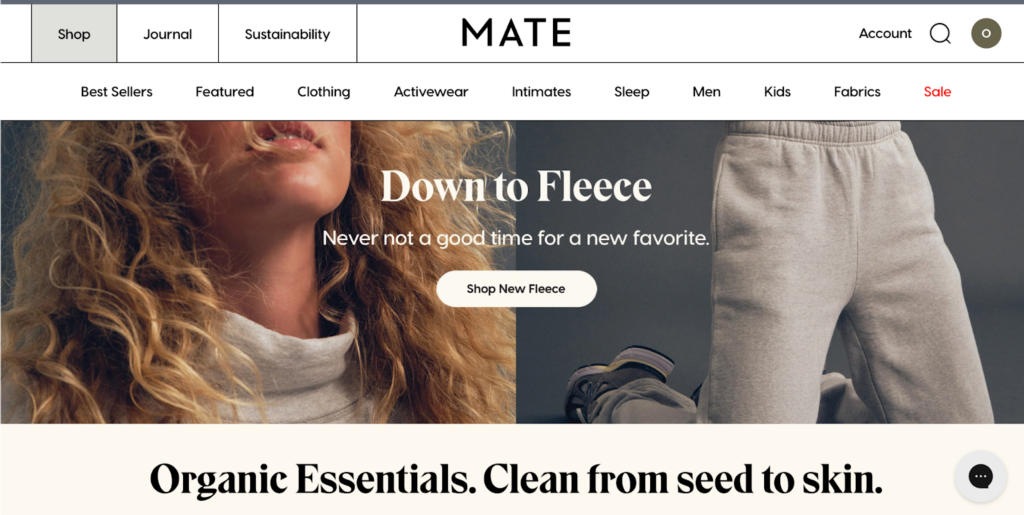
“To provide people everywhere with essentials that are clean from seed to skin.”
MATE the Label
🌎
How do they ensure their sustainability?
MATE the Label ensures sustainability by sourcing low-impact natural materials, reducing carbon footprints, and recycling. They opt for plant-based yarns and non-toxic dyes. At least 50% of their clothing items are made with organic or recycled plant fibers such as organic cotton or recycled cotton. They manufacture locally (within 15 miles of their office) to reduce transportation emissions. The brand diverts their textile waste (pre- and post-consumer) into making new products. They have B Corporation and Climate Neutral certifications.
🌐
How do they ensure their ethics?
MATE the Label has a Code of Conduct covering some ILO Four Fundamental Freedoms principles. Specifically, they do final production in US factories where they had banned, since day 1, the piece rate pay—a practice that often leads to wages below minimum wage and unsafe working conditions. They commit to creating safe, comfortable, and fair working environments for everyone in their supply chain, including farmers, garment workers, and recyclers. They also make regular visits to their suppliers.
🤝
Are they part of any giving-back programs?
In 2021, MATE the Label donated 1% of sales to nonprofit partners that are committed to saving the planet. On Giving Tuesday in 2021, they upped the donation from 1% of every purchase to 5%. Since their partnership with BEAM Impact, MATE the Label’s consumers can choose to which organization the donations of their order should go to.
🛍️
What is their product range?
- Best for: minimalistic, versatile clothes for women
- Product range: sweaters, dresses, pants, hoodies, sweatshirts, maternity, blouses, T-shirts, jumpsuits, underwear
- Price range: $$
- Size range: XS–XL
Rapanui: Made-to-Order Clothes Using Highly Sustainable Materials


“Our commitment to a cleaner way of living and doing business has made us stronger and, like any good relationship, we take every day as it comes.”
Rapanui
🌎
How do they ensure their sustainability?
Rapanui promotes sustainability by sourcing organic and recycled materials, operating on renewable energy, and removing plastic from packaging. Their products are designed for the circular economy, where they can be returned and remade. They recover organic material from worn-out Rapanui products sent back to them and blend them with organic cotton to make new yarn. They print their clothes in real-time, making what people need when they need it while reducing both the waste and the cost. Their packaging is plant-based instead of plastic. Furthermore, about 95% of the water used to dye Rapanui products is recovered, cleaned, and recirculated. Furthermore, their supply chain uses renewable energy (solar and wind).
🌐
How do they ensure their ethics?
Rapanui traces most of their supply chain.
🤝
Are they part of any giving-back programs?
Rapanue shares access to the supply chain and the technology they have developed on Teemill. This open-source circular fashion platform empowers other entrepreneurs to start their own sustainable clothing brands.
🛍️
What is their product range?
- Best for: menswear, womenswear
- Product range: T-shirts, jumpsuits, playsuits, pants, shorts, hoodies, sweatshirts, socks, underwear
- Price range: $
- Size range: S–L
Organic Basics: A Carbon Neutral Brand Creating Underwear, Activewear, and Everyday Essentials


“We make our basics to be both Earth- and people-friendly — carefully choosing materials and fabrics that care for our environment, only partnering with factories that consider their impact too, and designing all the basics for all bodies.”
Organic Basics
🌎
How do they ensure their sustainability?
Organic Basics promotes sustainability by choosing fabrics based on their environmental footprint and lifetime durability. Their clothes are made exclusively with natural fabrics (organic cotton certified by the Global Organic Textile Standard), low-impact textiles (TENCEL™ lyocell certified by the STANDARD 100 by OEKO-TEX®), or recycled materials (recycled nylon certified by the Global Recycling Standard). They use a small percentage of elastane in some garments to extend the products’ longevity, which ultimately extends the lifespan. Organic Basics is fully transparent about the impact of their products, enabling consumers to understand their share in using the clothes. Organic Basics partners with Made2Flow, which calculates their emissions, and One Carbon World, which helps them reduce and offset all their emissions. Finally, they are also a B Corporation.
🌐
How do they ensure their ethics?
Organic Basics works only with trusted, certified factory partners, who ensure that their workplace is free of child labor and forced labor and that their workers enjoy a safe working space, earn a living wage, and benefit from employee perks like free lunches and childcare. They show full transparency of the location and practices in their factories. Organic Basics also audits or visits most of their suppliers.
🤝
Are they part of any giving-back programs?
Organic Basics donates 1% of the value of all orders to sustainable projects. Their partnership with Beam Impact enables consumers to choose where their 1% donation will go, at no extra cost to the consumers, to support local charities that help Nature Conservation, Ocean Conservation, Rewilding, or Sustainability & Gender Equity.
🛍️
What is their product range?
- Best for: womenswear, menswear
- Product range: underwear, bras, bottoms, T-shirts, tops, sweatshirts, hoodies, knitwear dresses, swimwear, socks, plus-size
- Price range: $$$
- Size range: XXS–XXL
People Tree: The Pioneer to Fair Trade Fashion
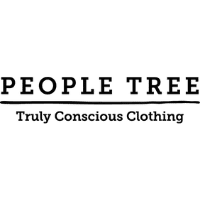
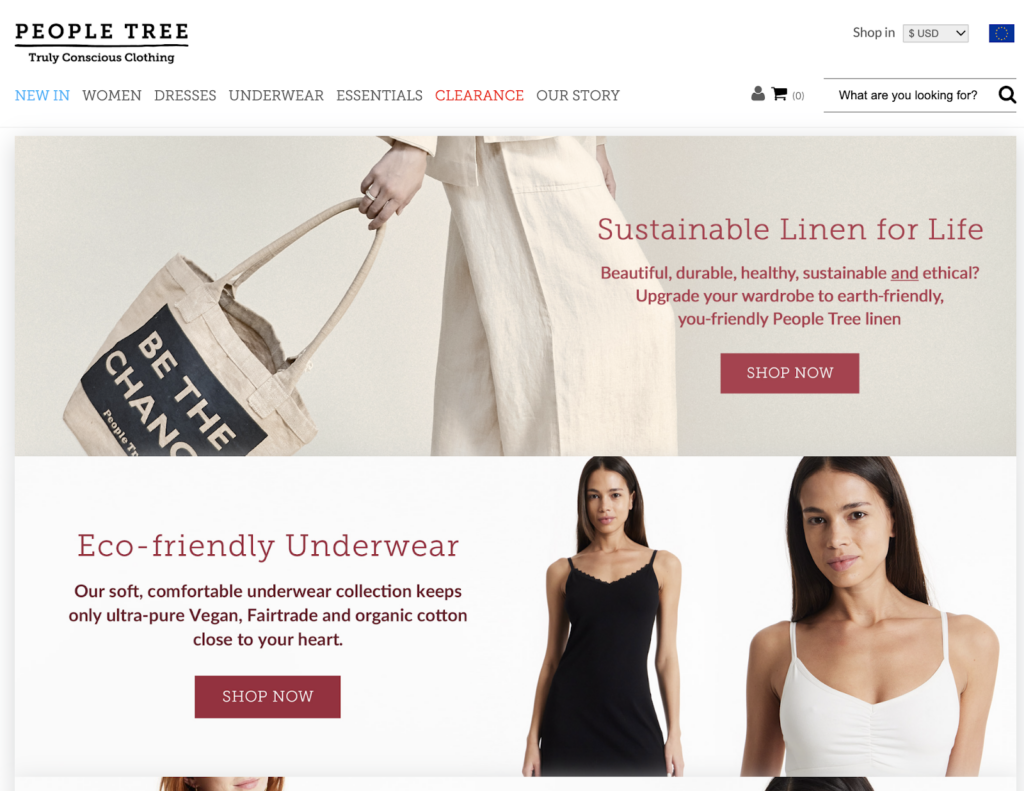
“ We build awareness to empower customers and producers to participate in Fair Trade and environmentally sustainable solutions.”
People Tree
🌎
How do they ensure their sustainability?
People Tree ensures sustainability by opting for low-impact materials, processes, and techniques. They only use natural fabrics made with low-impact fibers such as GOTS-certified organic cotton and linen or semi-natural/ semi-synthetic fabrics that follow closed-loop processes (such as TENCEL™). The brand uses low-waste cutting techniques to maximize fabric use. Their packaging is recyclable.
🌐
How do they ensure their ethics?
People Tree puts fair trade and ethical production practices at the core of the brand. They are a pioneer of fair trade fashion, guaranteeing better prices, decent working conditions, local sustainability, and fair terms of trade for farmers and workers in the Global South. They are also a member of the World Fair Trade Organization, which works on the 10 Principles of Fair Trade, including opportunities for disadvantaged producers and a commitment to no child labor or forced labor.
🤝
Are they part of any giving-back programs?
People Tree is actively involved in initiatives to improve access to education for adults and children in the most vulnerable communities and programs that support people with disabilities and disadvantages. They also campaign for fair trade, sustainability, and social justice.
🛍️
What is their product range?
- Best for: womenswear
- Product range: skirts, dresses, pants, tops, blouses, jumpsuits, socks, underwear
- Price range: $$
- Size range: S–XL
Toad&Co: Made-to-Order Clothes Using Highly Sustainable Materials
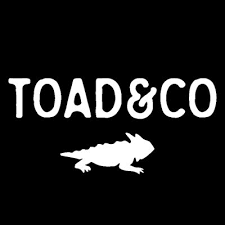
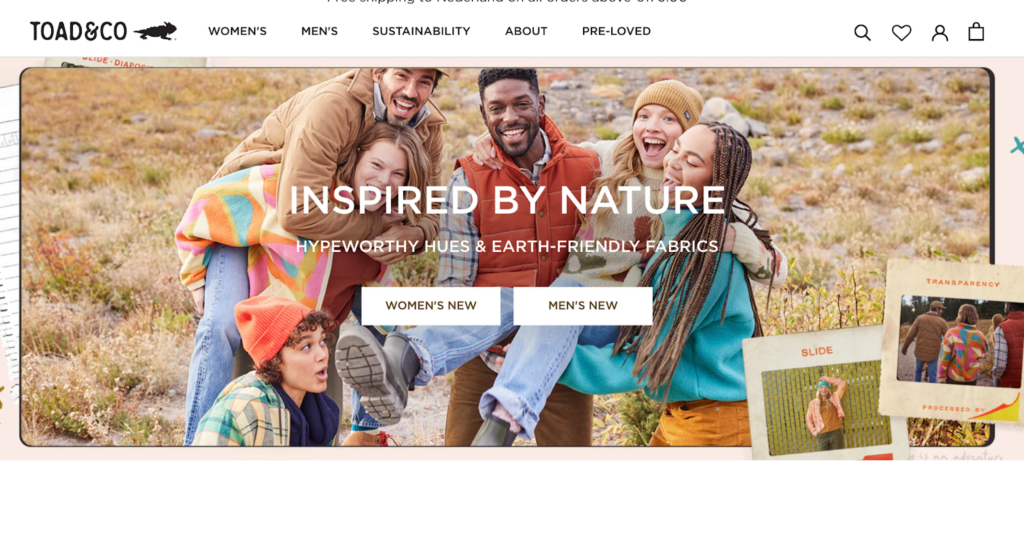
“Our commitment to a cleaner way of living and doing business has made us stronger and, like any good relationship, we take every day as it comes.”
Toad&Co
🌎
How do they ensure their sustainability?
Toad&Co promotes sustainability by sourcing eco-friendly materials, reducing carbon footprints, supporting textile circularity, and joining the responsible packaging movement. 100% of Toad&Co clothing is made with a minimum of 80% sustainable fibers and/or fabrics that have met Earth-friendly standards in accordance with Bluesign or Standard 100 by OEKO-TEX®. They use organic cotton, recycled fabrics, hemp, and TENCEL™. Furthermore, they purchase Renewable Energy Certificates (RECs) for all Toad&Co locations to offset their energy use by supporting the development of emission-free renewable energy and carbon reduction projects. The ToadAgain platform enables reselling and buying pre-loved items to reduce waste and extend the lifespan of clothing items. Additionally, Toad&Co provides resources for consumers to mend and extend the usage of their clothes.
🌐
How do they ensure their ethics?
Toad&Co is committed to promoting fair labor practices and safe working conditions in all factories in their supply chain. Their manufacturers are held to Toad&Co’s Workplace Code of Conduct to provide employees with a sustainable work environment. Their Code of Conduct follows the ILO Four Fundamental Freedoms principles. They also visit vendors’ facilities on a yearly basis to ensure that their clothes are produced with integrity. In 2010, Toad&Co was named one of Outside Magazine’s best places to work.
🤝
Are they part of any giving-back programs?
At the very beginning of their journey, Toad&Co co-founded Planet Access Company, which employs adults with disabilities, fostering inclusivity and diversity in the workforce. Additionally, they run programs that support people with disabilities to make arts and enjoy outdoor adventures. They also give 1% of all sales to environmental causes via 1% for the Planet membership. In the last 20 years, they have helped to fund 120 environmental protection organizations.
🛍️
What is their product range?
- Best for: menswear, womenswear
- Product range: shirts, sweaters, dresses, pants, maternity wear, T-shirts, shorts, underwear
- Price range: $$
- Size range: XS–XL
Pact: Stylish, Comfortable, Essential Clothing Made Ethically and Sustainably


“We believe the planet, and the people on it, should always come first in fashion.”
Pact
🌎
How do they ensure their sustainability?
Pact ensures sustainability by using low-impact textile and packaging materials, offsetting the carbon impact of all their products, and facilitating the donation of used clothes to reduce waste. They use a high proportion of eco-friendly fabrics, including GOTS-certified organic cotton. Additionally, their clothes are delivered in the VelaTM paper bags. These bags are made with carbon-neutral, FSC-certified, recyclable paper. Pact also partners up with SimpliZero. This partnership enables measuring the impact of every product Pact makes and offsetting it through reforestation, renewable energy, and community projects sequestering carbon from the atmosphere. Their Give Back Box incentive enables their customers to reuse the boxes their pact orders came in and donate their used clothes to local charities with the postal fee paid for by Pact.
🌐
How do they ensure their ethics?
Pact uses Fair Trade CertifiedTM factories, providing safe working conditions, community support, and additional development funds to workers in their supply chain. They trace most of their supply chain, including all of the final stages of production.
🤝
Are they part of any giving-back programs?
Pact is not known to be part of any giving-back programs.
Rozenbroek: High-Quality Clothing Made With Solar Energy
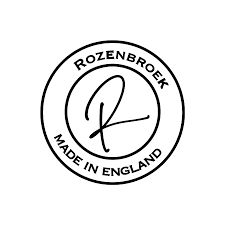
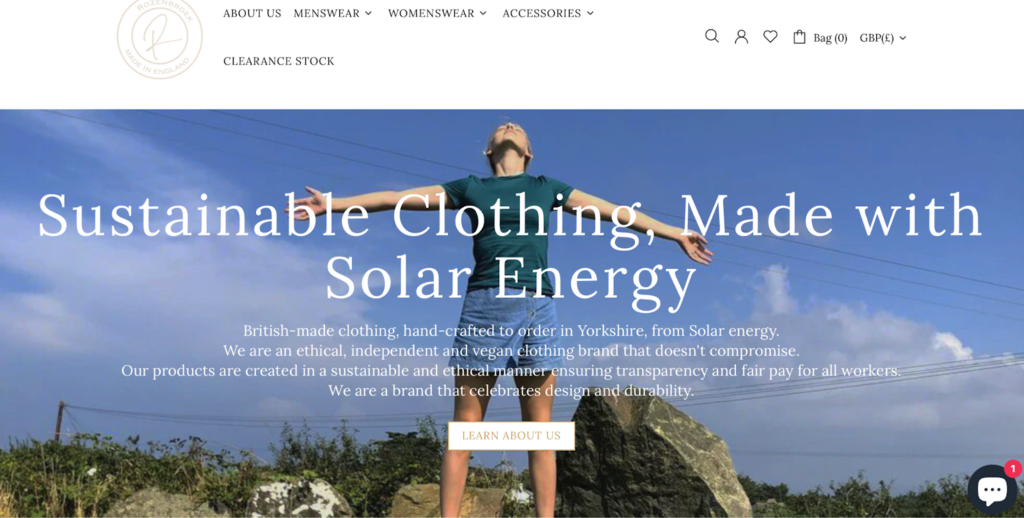
“We are an ethical, independent, and vegan brand that doesn’t compromise.”
Rozenbroek
🌎
How do they ensure their sustainability?
Rozenbroek ensures sustainability by sourcing organic plant fibers, reducing textile waste, and manufacturing using solar energy. They use a high proportion of low-impact materials, including GOTS-certified organic cotton and OEKO-TEX-certified organic bamboo. Furthermore, they use recycled, recyclable, compostable, or biodegradable packaging for all purchases. Regarding waste reduction, Rozenbroek operates on small batches or made-to-order to reduce inventory while recycling most of their offcuts to make tote bags, scrunchies, and face masks. Lastly, they lower their carbon footprint by making clothes in their own factory powered by solar panels on the roof.
🌐
How do they ensure their ethics?
Rozenbroek visits their factory regularly and pays the textile workers a living wage.
🤝
Are they part of any giving-back programs?
Rozenbroek is not known to be part of any giving-back program.
🛍️
What is their product range?
- Best for: menswear, womenswear
- Product range: shirts, denim, jackets, blazers, tops, blouses, T-shirts, bodysuits, underwear
- Price range: $$$
- Size range: XS–XXL
Cotton Fabrics: Breathable and Biodegradable Plant Material
Cotton is a great material from nature as its breathability helps lower the impact of the usage phase. At the end of their life, pure cotton fabrics are readily biodegradable and suitable for composting.
Here are the life-cycle stages of cotton fabrics and each stage’s sustainability assessment:
- Sourcing of cotton fabrics: Sourcing conventional-cultivated cotton fiber is mostly unsustainable because the cotton crop is water-thirsty and vulnerable to various pests. Also, the widespread monoculture in cotton cultivation depletes the soil and necessitates synthetic fertilizer in many growing regions. However, it can be sustainable to source responsible, regenerative, organic cotton from systems that improve the health of the ecosystem. Sourcing recycled cotton is also highly sustainable as it avoids more pressure on natural resources (land and water).
- Manufacturing of cotton fabrics: Manufacturing cotton fabrics is generally not very sustainable because it involves harmful synthetic chemicals. Also, cotton manufacturing is energy-intensive. High energy usage could have serious knock-on ecological impacts if manufacturing relies heavily on fossil fuels. Alternatively, manufacturing recycled cotton has a high energy demand, particularly regarding breaking down textile waste to retrieve the fibers. The mechanical process of breaking down waste to recover the fibers often shortens the fiber length and, thus, can’t be repeated indefinitely (to allow recycled cotton to be truly circular).
- Transportation of cotton fabrics: Transporting can be a carbon-intensive stage in the life-cycle of clothing items made with cotton fabrics due to the distances covered and emissions associated with transporting vehicles. Cotton fabrics typically travel from cotton fields (virgin cotton) or collection hubs (recycled cotton) to processing and finishing factories, sorting centers, shops, and consumers’ homes before going to recycling centers or landfills.
- Usage of cotton fabrics: Cotton fabrics are breathable. Furthermore, they don’t need to be washed too frequently, saving water and energy.
- End-of-life of cotton fabrics: The end-of-life stage for cotton fabric is generally sustainable because it is reusable, biodegradable, and compostable.
Cotton fabrics are on a spectrum from unsustainable to sustainable, with responsible, regenerative, organic, and recycled cotton fibers making the most sustainable materials. Particularly, recycled cotton is often considered a preferred textile option because recycling waste reduces pressure on land, water, and other resources needed for cotton cultivation.
Why Is It Important to Buy Products Made of More Sustainable Fabrics
It is important to buy products made of more sustainable fabrics because a sustainable textile industry has a lower carbon footprint, helps save natural resources, and is better for forests, animals, and humans.
Buying Sustainable Fabrics Reduces Your Carbon Footprint
The production of clothing and footwear is estimated to contribute 10% of global greenhouse gas emissions—more than all international flights and shipping combined. If the fashion industry were a country, it would be the fourth largest emitter of carbon dioxide.
One way to reduce the carbon footprint of the clothes you buy is to opt for sustainable fabrics. Sustainable fabrics, which are often made with natural or recycled fibers, have relatively low carbon footprints compared to petroleum-based fabrics. For example, organic cotton made in the US has a carbon footprint of 2.35 kg CO2 (per ton of spun fiber)—a quarter of polyester’s carbon footprint.
Buying Sustainable Fabrics Reduces Demand For Natural Resources and Waste Management
The textile industry uses water and land to grow cotton and other fibers. It is estimated that 79 billion cubic meters of water were used for the sector worldwide in 2015. For example, producing a single cotton t-shirt requires as much water as one person drinks for 2.5 years (2,700 liters of fresh water).
Worse yet, the textile economy is vastly more linear than circular: the largest amount of resources used in clothes ended up in landfill (instead of being recycled to remake clothes). According to a report by the Ellen MacArthur Foundation,
- Less than 3% of materials used in the textile economy in 2015 came from recycled sources.
- In other words, more than 97% of resources used in making clothes are newly extracted.
When clothing items are disposed of within a short period of time—under a year in the case of half of the fast fashion clothes—the natural systems that provide raw materials for fabrics don’t have enough time to recover and regenerate, which could lead to ecological breakdown.
Sustainable fabrics are made with less water and emissions while lasting longer:
- Because they are durable, you don’t need to buy new clothes too often.
- Thus, you help reduce the pressure to extract more resources for making new items.
Similarly, making and consuming sustainable fabrics made with recycled materials reduces the demand for virgin materials while helping tackle waste management.
Buying Sustainable Fabrics Encourages Sustainable Management of Forests
Sustainable plant-based fabrics are made with raw materials from forests and plantations that are sustainably managed, such as complying with FSC standards.
When you buy sustainable plant-based fabrics, you discourage unsustainable forestry practices like illegal logging. You can help reduce deforestation, biodiversity loss, and the effect of climate change.
Buying Sustainable Fabrics Encourages Fairer Treatment of Animals
The fashion industry is rife with animal mistreatment when it comes to making animal-based fabrics like wool or silk. Every year, billions of animals suffer and die for clothing and accessories.
Buying sustainable vegan alternatives can help to reduce the pressure on raising more and more animals to meet the demand for animal-based fabrics while sacrificing their well-being and lives.
Suppose you have to buy fabrics made with, for example, wool or silk; make sure you only choose brands committed to cruelty-free products. In that case, you help advocate better treatments for animals raised within the textile industry.
Using Sustainable Fabrics Encourages Fairer Treatment of Textile Workers
Recent statistics from UNICEF estimated as many as 170 million child laborers worldwide, many of whom were engaged in some form of work in the textile industry. They don’t get paid minimum wages and often work long hours.
When you buy sustainable fabrics from brands transparent about the working conditions at their factories, you discourage the use of child labor and help promote better working conditions for textile workers.
How Can You Generally Buy More Sustainable Fabrics
The key to sustainably buying fabrics is to check on relevant environmental and original certifications.
For natural fabrics:
- Global Organic Textile Standard (GOTS): A globally recognized certification system that ensures a certain threshold of organic content has been met. It covers manufacturing, packaging, labeling, transportation, and distribution (but not what happens in the fields where crops are grown).
- USDA Certified Biobased Product: The USDA BioPreferred® Certification is a voluntary certification offered by the United States Department of Agriculture. The certification identifies products made from plants or other renewable materials.
- Ecolabel: Ecolabel is the official European Union voluntary label recognized worldwide for certified products with a guaranteed, independently verified low environmental impact. The label requires high environmental standards throughout the entire life-cycle: from raw material extraction through production and distribution to disposal. It also encourages companies to develop innovative, durable, easy-to-repair, and recyclable products.
For plant-based semi-natural/semi-synthetic fabrics:
- Forest Stewardship Council: An FSC certification ensures that the wood (or wood-like material) comes from responsibly managed forests that provide environmental, social, and economic benefits.
There are two types of FSC Certification:- FSC Forest Management Certification, with a focus on the origin of the wood—the forest.
- FSC Chain of Custody Certification, which focuses on the path from the forest to the customer’s home.
- Program for Endorsement of Forest Certification: PEFC’s approaches to sustainable forest management are in line with protecting the forests globally and locally and making the certificate work for everyone. Getting a PEFC certification is strict enough to ensure the sustainable management of a forest is socially just, ecologically sound, and economically viable but attainable not only by big but small forest owners.
For recycled fabrics:
- Recycled Claim Standard (RCS): The Textile Exchange RCS was originally developed as an international, voluntary standard that sets requirements for third-party certification of Recycled input and chain of custody.
- The Global Recycled Standard (GRS): The Global Recycled Standard (GRS) is an international, voluntary, full product standard that sets requirements for third-party certification of Recycled Content, chain of custody, social and environmental practices, and chemical restrictions. It can be used for any product with more than 20% recycled material.
For all types of fabrics:
- STeP by OEKO-TEX®: STeP by OEKO-TEX® is an independent certification system for brands, retailers, and manufacturers from the textile and leather industry. It communicates organizational environmental measures, including reducing carbon footprint and water usage.
- OEKO-TEX® Standard 100: OEKO-TEX® labels aim to ensure that products pose no risk to human health (i.e., containing banned chemicals).
Some certifications that are signaling brands’ efforts toward lowered environmental impacts and a circular economy are:
- B Corp Certification: The label B Corp is a certification reserved for for-profit companies. Certified holders are assessed on their social and environmental impacts.
- Cradle2Cradle certification: Cradle2Cradle provides a standardized approach to material circularity. It assesses whether products have been suitably designed and made with the circular economy in mind covering five critical categories: material health, material reuse, renewable energy and carbon management, water stewardship, and social fairness.
Final Thoughts
Cotton fabrics are on a spectrum from unsustainable to sustainable, largely depending on the farming systems. Responsible, regenerative, and organic cotton fabrics are sourced from farms where the general health and recovery of the land are taken care of, leading to higher sustainability. Additionally, recycled cotton is among the most sustainable textile materials largely because recycling cotton waste reduces pressure on land, water, and other resources needed to grow new crops.
By purchasing new or pre-loved responsible, regenerative, organic, and recycled cotton clothes from brands that commit to sustainability, you support their mission to create a fairer and less harmful textile industry for all lives on Earth.
Here is the list (again) of the most sustainable cotton clothing brands:
- Patagonia
- Reformation
- Tentree
- Eileen Fisher
- Outerknown
- Ecoalf
- Neu Nomads
- Whimsy + Row
- MATE the Label
- Rapanui
- Organic Basics
- People Tree
- Toad&Co
- Pact
- Rozenbroek
To make your use of these fabrics even more sustainable, follow these steps:
- Buy second-hand, recycled, or upcycled clothes made with responsible, regenerative, organic cotton.
- While using cotton clothes, maximize the number of wears between washes and keep them as long as possible.
- At the end-of-life of your cotton clothes, upcycle the materials to extend their usage and arrange for them to be recycled or properly disposed of.
Stay impactful,

Sources
- CFDA: COTTON
- Impactful Ninja: How Sustainable Are Cotton Fabrics? A Life-Cycle Analysis
- Britannica: cotton | fiber and plant
- Impactful Ninja: How Sustainable Are Organic Cotton Fabrics? A Life-Cycle Analysis
- Impactful Ninja: How Sustainable Are Recycled Cotton Fabrics? A Life-Cycle Analysis
- Common Objective: REPORTS & TOOLS | MADE-BY ENVIRONMENTAL BENCHMARK FOR FIBERS
- Science Direct: Life-cycle assessment (LCA)
- Patagonia: Home
- Reformation: Home
- Tentree: Home
- Eileen Fisher: Home
- Outerknown: Home
- Ecoalf: Home
- Neu Nomads: Home
- Whimsy + Row: Home
- MATE the Label: Home
- Rozenbroek: Home
- Rapanui: Home
- Organic Basics: Home
- People Tree: Home
- Toad&Co: Home
- Pact: Home
- Patagonia: The Climate Crisis Is Our Business
- Patagonia: The Climate Crisis Is Our Business | No More Virgin Petroleum Fibers by 2025
- Patagonia: The Climate Crisis Is Our Business | Is Each Product Worth the Environmental Cost?
- Patagonia: The Climate Crisis Is Our Business | Help Suppliers Cut Emissions
- Patagonia: Environmental Responsibility
- Patagonia: Recycled Cotton
- Patagonia: Regenerative Organic Certified fibers
- Patagonia: Hemp
- Patagonia: Man-made Cellulose Fibers
- Patagonia: WORN WEAR
- B Corporation: Patagonia
- Bluesign®: Home
- Fair Trade: Home
- FAIR TRADE CERTIFIED: Improving Lives, Protecting the Planet.
- Patagonia: Social Responsibility
- Patagonia: Fair Trade
- Patagonia: Fair Labor Association
- Patagonia: Living Wage Program
- Patagonia: Migrant Workers Program
- Patagonia: Responsible Purchasing Practices
- Patagonia: Where We Do Business
- Patagonia: Patagonia Wool Standard (PWS) For Animal Welfare, Land Management and Traceability
- Textile Exchange: Responsible Wool Standard
- Patagonia: 1% for the Planet
- Forbes: Yvon Chouinard And The Patagonia Purpose Trust— What Is It And Will It Work?
- Fast Company: Patagonia uses capitalism to save the planet with the Holdfast Collective
- The New York Times: Patagonia Founder Gives Away the Company to Fight Climate Change
- Reformation: Sustainability
- Impactful Ninja: How Sustainable Are TENCELTM Fabrics? A Life-Cycle Analysis
- TencelTM: TENCEL™ x REFIBRA™ technology
- Reformation: Circularity
- Reformation: RefRecycling
- Reformation: What is RefScale
- CLIMATE NEUTRAL: Reformation
- The Reformation: Supplier Code of Conduct
- International Labor Organization (ILO): Home
- Reformation: Supplier Code of Conduct
- Reformation: Factories
- Transparency Pledge: Home
- Open Supply Hub: Home
- Fair Labor Association: Home
- Tentree: Tree Planting FAQ
- Tentree: Circularity By tentree
- Tentree: Our Materials
- Tentree: Thinking Outside the Box
- Tentree: WE’RE TENTRE | We Believe Big Change Starts Small.
- SuperCircle: Home
- Treet: Home
- Tentree: SuperCircle
- Impactful Ninja: How Sustainable Are Hemp Fabrics? A Life-Cycle Analysis
- Impactful Ninja: How Sustainable Are Recycled Polyester? A Life-Cycle Analysis
- B Corporation: Tentree
- CLIMATE NEUTRAL: Tentree
- Tentree: Ethical Manufacturing
- Good On You: Brand Directory | Tentree
- Fair Wear Foundation: Home
- Global Organic Textile Standard: Home
- Sedex Members Ethical Trade Audit: Home
- Worldwide Responsible Accredited Production – WRAP: Home
- Shopify: Ten Tree International Inc. (tentree) | Commitment to Protect Forests Through Our Paper, Packaging and Fabrics Choices
- Tentree: THE ENVIRONMENTOR | Here’s Where We Plant Your Trees
- Tentree: 04 nature | TENTREE SUSTAINABILITY
- Eilleen Fisher RENEW: Home
- Eileen Fisher: OUR VISION2020 RESULTS
- Eileen Fisher: Our Brand
- B Corporation: Eileen Fisher
- Good On You: Brand Directory | Eileen Fisher
- Eileen Fisher: Community | Love, Peru. Our Fair Trade Project.
- CFDA: HOW EILEEN FISHER IS THE ULTIMATE SUSTAINABLE LABEL
- Seek Capital: 11 Small Business Grants For Women
- Impactful Ninja: How Sustainable Are Wool Fabrics? A Life-Cycle Analysis
- Outerknown: Progress Every Step Of The Way
- Outerknown: What is Outerworn?
- Shopify: OUTERKNOWN Supplier Code of Conduct
- Fair Labor Association: Home
- International Labour Organization: ILO Declaration on Fundamental Principles and Rights at Work
- Fairtrade: Fairtrade Premium
- Brother Benno: Home
- The Ocean Cleanup: Home
- Ocean Conservancy: Home
- Surfrider Maui Chapter: Home
- Surfrider Foundation: Home
- Everytown: Home
- Ecoalf: Materials
- Ecoalf: History
- Ecoalf: DON’T THINK IT’S A UTOPIA | DISCOVER OUR 2021 SUSTAINABILITY REPORT
- Impactful Ninja: How Sustainable Are Recycled Fabrics? A Life-Cycle Analysis
- Impactful Ninja: How Sustainable Are Recycled Wool Fabrics? A Life-Cycle Analysis
- Impactful Ninja: How Sustainable Are Recycled Polyester Fabrics? A Life-Cycle Analysis
- Impactful Ninja: How Sustainable Are Recycled Nylon Fabrics? A Life-Cycle Analysis
- Impactful Ninja: How Sustainable Are Natural Fabrics? A Life-Cycle Analysis
- Impactful Ninja: How Sustainable Are Kapok Fabrics? A Life-Cycle Analysis
- B Corporation: Ecoalf
- Ecoalf: Sustainable Report 2021 | DON’T THINK IT’S A UTOPIA
- Ecoalf: ECOALF foundation
- Ecoalf: Upcycling the Oceans
- Ecoalf: Because There’s No Planet B
- Ecoalf: Personas
- Neu Nomads: EVERYTHING CONSIDERED
- Good On You: Brand Directory | Neu Nomads
- Neu Nomads: FULL CIRCLE
- Whimsy + Row: ABOUT OUR FABRIC
- Whimsy + Row: OUR VALUES & SUSTAINABILITY
- Good On You: Brand Directory | Whimsy + Row
- Whimsy + Row: OUR STORY
- Carbon Fund: Home
- One Tree Planted: Home
- Black Lives Matter: Home
- Feeding America: Home
- Good On You: Brand Directory | MATE the Label
- MATE the Label: Dress Clean
- B Corporation: MATE the Label
- CLIMATE NEUTRAL: MATE the Label
- MATE the Label: 2021 Impact Report
- Rapanui Clothing: Journey
- Rapanui Clothing: The future, remade.
- Good On You: Brand Directory | Rapanui Clothing
- Teemill: A Circular Economy Supplier
- Organic Basics: FAQ
- Global Organic Textile Standard (GOTS): Home
- OEKO-TEX: STANDARD 100 by OEKO-TEX®
- Textile Exchange: The RCS and GRS are designed to boost the use of recycled materials.
- Impactful Ninja: How Sustainable Are Elastane Fabrics? A Life-Cycle Analysis
- Made2Flow: Home
- One Carbon World: Home
- B Corporation: Organic Basics
- Organic Basics: Factories
- Good On You: Brand Directory | Organic Basics
- Organic Basics: Our Impact
- Beam Impact: Home
- Impactful Ninja: How Sustainable Are Semi-Natural/ Semi-Synthetic Fabrics Fabrics? A Life-Cycle Analysis
- Good On You: Brand Directory | People Tree
- People Tree: Our Story
- One World Shop: 10 Principles of Fair Trade
- TOAD&CO: A TOAD IS BORN
- TOAD&CO: SUSTAINABILITY
- TOAD&CO: THE CIRCULAR ECONOMY
- TOAD&CO: OUR PACKAGING JOURNEY
- FIBRE2FASHION: Interview With Gordon Seabury
- OEKO-TEX: Standard 100 by OEKO-TEX®
- THE INTERNATIONAL REC STANDARDS: HOME
- TOAD&CO: OUR HISTORY
- TOAD&CO: ToadAgain Platform
- TOAD&CO: WORKPLACE CODE OF CONDUCT
- TOAD&CO: GOOD BUSINESS
- Planet Access Company: Home
- TOAD&CO: EVERYONE DESERVES OPPORTUNITIES
- SEARCH INC: SEARCH FOR ADVENTURE
- TOAD&CO: GOOD PRODUCTS ARE NOTHING WITHOUT GOOD INTENTIONS
- One Percent For The Planet: Home
- Good On You: Brand Directory | Pact
- VelaTM paper bags: Home
- Pact: Responsible Packaging
- SimpliZero: Home
- Pact: Sustainability, Certified
- Pact: Give Back Box
- Rozenbroek: About Us
- Good On You: Brand Directory | Rozenbroek
- OEKO-TEX: Home
- Impactful Ninja: How Sustainable Are Bamboo Fabrics? A Life-Cycle Analysis
- Intechopen: Natural Fibers: The Sustainable Alternatives for Textile and Non-Textile Applications
- European Parliament: The impact of textile production and waste on the environment (infographic)
- Science Direct: The challenge of “Depeche Mode” in the fashion industry – Does the industry have the capacity to become sustainable through circular economic principles, a scoping review
- Science Direct: Carbon Footprint of Textile and Clothing Products
- European Parliament: Environmental impact of the textile and clothing industry
- European Parliament: What if fashion were good for the planet?
- Ellen MacArthur Foundation: A New Textiles Economy: Redesigning fashion’s future
- McKinsey: Style that’s sustainable: A new fast-fashion formula
- Forest Stewardship Council: Home
- Our World in Data: Deforestation and Forest Loss
- Our World in Data: Renewable Energy
- Peta: Animals Used For Clothing
- The Guardian: Child labour in the fashion supply chain
- BioPreferred: WHAT IS THE BIOPREFERRED PROGRAM?
- European Commission: Environment | EU Ecolabel
- Forest Stewardship Council
- FSC Forest Management Certification
- FSC Chain of Custody Certification
- Program for Endorsement of Forest Certification
- Textile Exchange: The RCS and GRS are designed to boost the use of recycled materials
- OEKO-TEX: Certification according to STeP by OEKO-TEX®
- B Corp Certification: Home
- C2CCertified: Home




